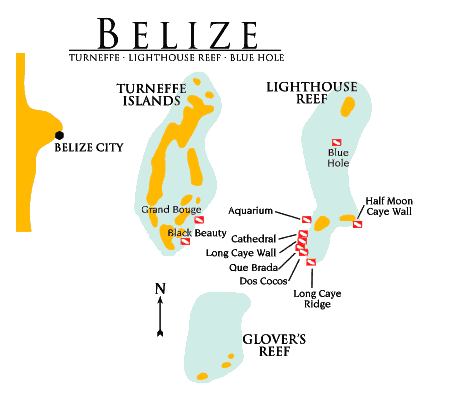
Where in the World?
From the Jungle to the Sea Expedition begins in the country of Belize.
The Browns boarded the Belize Aggressor III in Belize City. From there they
traveled into the Caribbean Sea to spend a week diving to investigate
the largest coral reef in the Western Hemisphere.
Here are some of the dive sites that we explored during the expedition
with a short explanation about each site:

Turneffe Islands Atoll
Black Beauty: This area has long mounds of coral with sandy bottom channels. The underwater drop-off begins around 50 ft. It is named for the large black corals we saw growing along the underwater drop-off.
Grand Bogue: This site is home to the elusive white spotted, white lined and large-eyed toadfish.
Lighthouse Reef Atoll
Aquarium: This is like an aquarium you can swim in! A sheer underwater wall begins around 30 ft. underwater. There is an abundance of fish life at the top. About 40-60 ft. deep along the wall are large barrel sponges, giant deep water sea fans, and the richest collection of deep water gorgonians almost anywhere in the world. Giant elephant ear sponges, yellow tube sponges and azure vase sponges make this a very colorful area. At the very corner of this reef saw a nurse shark, big black groupers, and swirling schools of horse-eye jacks.
Cathedral: Here we found colorful coral reef formations resembling cathedral steeples. This site is home to many black groupers and jacks, as well as three species of angel fish, scorpion fish, several varieties of eels and silver sides.
Long Caye Wall: Named for a protruding wall of coral reef. It has many swim throughs with grooves which cut the underwater wall running directly to the open sea. Many interesting soft corals and sea sponges are found here. We found many moray eels here, too!
Que Brada: Named for a cut in the reef (the wall and shallows), this is an extremely sheer and active stretch of wall. Because it projects out into the current, the extra flow of plankton around it supports an incredibly rich diversity of marine animals. We found green moray eels, lobsters, crabs, and tarpon on our night dives.
Dos Cocos: This was named for the two coconut trees on the shore of Long Caye Island that were used to locate this dive site. The last hurricane blew the trees down, but the name was not changed. We swam with a hawksbill turtle here.
Half Moon Caye Wall: This has underwater tunnels and grooves which slope down toward the deep water. We saw several different species of grouper and snapper in the tunnels. Along the underwater drop-off, we can saw spotted eagle rays, and sea turtles.
Blue Hole: The world's largest blue hole! The Blue Hole was formed by a huge underground cavern that was covered by the sea and collapsed. The first shelf of this collapsed underground cavern begins at 110 ft. underwater. Here we saw stalactites hanging from the ceiling. A healthy coral reef exists around the edge of the blue hole and is home to many juvenile sea creatures. We saw schools of parrot fish, squid, flaming scallops and several varieties of angel fish.